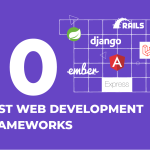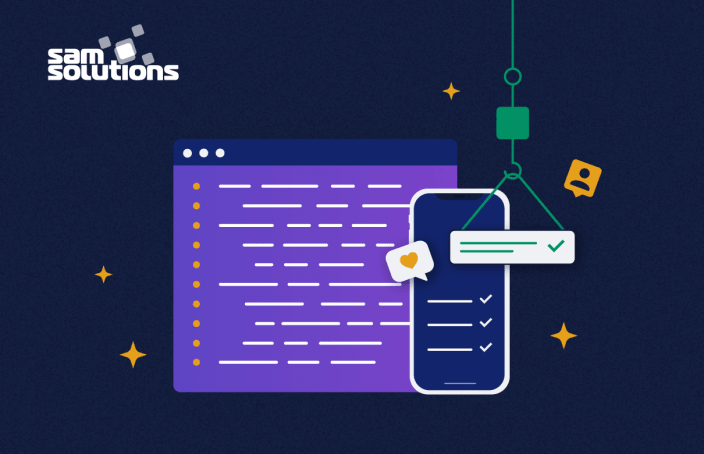Timely adoption of the latest information technologies is paramount for companies across many industrial sectors and spheres of life. By monitoring new trends in technology, businesses gain valuable insights that help them stay competitive and shape their digital journey in the years ahead.
Continue reading to discover the disruptive tech trends that may inspire new achievements in 2024.
Best Tech Trends 2024
This year’s list of the best technology trends includes: generative AI, cybersecurity, Continuous Threat Exposure Management, green tech, and platform engineering.
Develop your custom software with SaM Solutions’ engineers, skilled in the latest tech and well-versed in multiple industries.
1. Generative AI
The growth of AI use cases across industries is driven by the technology’s benefits including automated processes, data-based decision-making, enhanced customer experiences, and accelerated outcomes.
One prominent practical example is generative AI, which stands out among the latest technology trends in IT. Unlike traditional artificial intelligence solutions that primarily recognize, categorize, and analyze existing human-provided data, generative AI uniquely produces entirely new digital assets, including images, texts, videos, and audio content from the ground up.
- According to Statista‘s projections, the market size for generative AI is anticipated to reach $66.62 billion in 2024, with the United States accounting for the largest share at $23.20 billion.
- With an expected compound annual growth rate (CAGR) of 20.8% from 2024 to 2030, the generative AI market is poised to expand, reaching a substantial volume of $207 billion by the year 2030.
New content pieces, with no real-world analogs (e.g., generated images of people), can be utilized in marketing or advertising without infringing copyright laws or personal rights.
Alongside the evolving metaverse, generative AI will grow by creating characters and items for this “new universe,” gradually transforming into a profitable business.
2. Cybersecurity
In 2024, cybersecurity is at the forefront of tech trends, reflecting an intensified focus on digital defenses in response to escalating cyber threats.
As technology continues to advance, so do the tactics of malicious actors seeking unauthorized access to sensitive data and systems. Organizations across industries are prioritizing cybersecurity measures to safeguard their networks, applications, and data from potential breaches.
- 75% of security professionals have observed an increase in cyber attacks over the past year (CFO).
- Globally, 72.7% of all organizations fell prey to a ransomware attack in 2023 (Statista).
- Cybercrime is predicted to cost the world $9.5 trillion in 2024 (Cybersecurity Ventures).
- 31% of executives said their main cybersecurity challenge was improper identification of key risks (ThoughtLab).
- 66% of organizations expect their cybersecurity budget to grow in the coming year (ThoughtLab).
- The most used cybersecurity framework is ISO 27001/27002 (ThoughtLab).
The increasing sophistication of cyber attacks is driven by factors including the growing interconnectivity of IoT devices, widespread adoption of cloud computing, and continuous evolution of artificial intelligence and machine learning technologies.
Consequently, cybersecurity measures are advancing, integrating artificial intelligence, machine learning, and sophisticated encryption methods to actively identify and mitigate emerging threats. This dynamic approach reflects the industry’s proactive stance in addressing the evolving nature of cyberthreats.
3. Continuous Threat Exposure Management (CTEM)
Since technology trends for 2024 are defined with an eye on cybersecurity, Continuous Threat Exposure Management (CTEM) comes into focus. This is a proactive and dynamic approach to identifying, assessing, and mitigating security risks in real-time.
Unlike traditional security measures, CTEM involves continuous monitoring of an organization’s digital environment, providing a comprehensive view of potential vulnerabilities and threats. By leveraging automation, artificial intelligence, and machine learning, CTEM allows for rapid detection and response to emerging cyber threats.
This trend emphasizes a shift from periodic security assessments to a more robust, ongoing, and adaptive security framework that aligns with the evolving nature of cybersecurity challenges.
4. Green Tech
With a growing awareness of environmental challenges, companies are increasingly embracing eco-friendly tech innovations. Green technology (aka sustainable technology, climate technology) encompasses a diverse range of advancements that prioritize renewable energy sources, energy efficiency, sustainable construction materials, smart grid systems, and more.
In recent years, there has been a notable increase in investment in sustainable technologies and startups focused on environmental solutions.
The global green technology market size is projected to grow from $16.50 billion in 2023 to $61.92 billion by 2030, at a CAGR of 20.8% (Fortune Business Insights).
Moreover, the shift towards eco-conscious tech practices is not only driven by environmental concerns but also by the recognition of their economic benefits. Let’s examine some staggering facts related to traditional data centers:
- The electricity consumption of a single data center is equal to that of a small town.
- Approximately 3% of the world’s electricity is utilized by data centers.
- By 2030, data centers will contribute to 10% of the world’s total electricity consumption.
- As of 2021, data centers accounted for 1% of global carbon dioxide emissions, equaling the emissions produced by the entire aviation sector.
Green data centers
An alternative is switching to green data centers, which can help mitigate the environmental impact of the ever-expanding digital infrastructure. Green data centers use energy-efficient technologies based on renewable energy sources, such as solar or wind power, to store and process data. Additionally, innovations such as virtualization, high-efficiency cooling systems, and energy-efficient server designs contribute to significant energy savings.
The top technology trends that facilitate the reduction of carbon footprints and the creation of a more resilient and sustainable future for generations to come include:
- Smart grid systems – an intelligent approach to managing electrical grids. By integrating digital communication and control technologies, smart grids enhance the reliability and efficiency of energy distribution. They enable real-time monitoring, optimize energy usage, and facilitate the integration of renewable energy sources, such as wind and solar power.
- Electric vehicles (EVs) – electric cars, buses, and bikes powered by rechargeable batteries aim to reduce the usage of fossil fuel. EVs drastically decrease air pollution in urban environments. As technology evolves, advancements in battery efficiency and charging infrastructure contribute to making electric vehicles an increasingly viable and sustainable mode of transportation.
- Carbon capture and storage (CCS) technologies – a set of methods to capture and store carbon dioxide emissions from power plants and industrial facilities to reduce their environmental impact.
- Circular economy initiatives – the concept of a circular economy, which aims to minimize waste and capitalize resources. Companies are increasingly adopting sustainable practices, such as recycling, reusing materials, and designing products with a focus on longevity and easy recyclability.
5. Platform Engineering
The growing complexity of modern software solutions has triggered the emergence of platform engineering – a strategic approach to software development and system architecture. This discipline focuses on building robust and scalable platforms that enable the seamless integration of various services, tools, reusable components, and knowledge. The goal is to provide a foundation that enhances developer experience, streamlines the delivery of applications, supports current functionalities, and accommodates future innovations and scalability requirements.
Platform engineering emphasizes modular design, API-driven development, and the use of microservices to create flexible and interoperable systems.
As organizations strive for digital transformation and agility, platform engineering facilitates the development of cohesive ecosystems, fostering collaboration across different parts of an enterprise. This trend reflects a shift from traditional monolithic architectures to dynamic, interconnected platforms, empowering businesses to swiftly adapt to changing market demands and technological advancements.
Gartner predicts that by 2026, a significant majority – 80% – of large software engineering organizations will have implemented platform engineering teams. These teams will function as internal providers, offering reusable services, components, and tools to facilitate application delivery. Ultimately, platform engineering aims to address the core challenge of collaboration between software developers and operators.
Why Choose SaM Solutions as Your Technology Partner
Since entering the IT market in 1993, SaM Solutions has offered a comprehensive array of services, encompassing custom and platform-based software development, IT consulting, testing and QA, DevOps services, and more. Our extensive expertise spans various industries, including automotive, telecom, travel and hospitality, healthcare, logistics and transportation, retail, and manufacturing.
The SaM Solutions team, comprised of experienced developers and IT experts, leverages the latest technologies to create software products tailored to the unique needs of our clients. Our company’s unwavering focus is on delivering high-quality final products, ensuring resilience while maintaining cost-effectiveness.
The Technology World Is Moving Forward
Life has become digital in many aspects, and the tech world doesn’t stand still. Existing technologies continuously improve, while new ones emerge, offering further changes. That’s why it’s crucial for business leaders to keep abreast of the latest tech trends. This approach allows them to gain valuable insights into tech developments, quickly introduce innovations into their business processes, and remain competitive, even in uncertain times.



























 5 Reasons Why Your Business Needs a Mobile eCommerce Application
5 Reasons Why Your Business Needs a Mobile eCommerce Application Using Salesforce to Improve Your Sales Pipeline: Five Tips
Using Salesforce to Improve Your Sales Pipeline: Five Tips Cross-Platform Mobile Development: Five Best Frameworks
Cross-Platform Mobile Development: Five Best Frameworks How to Develop Custom Accounting Software
How to Develop Custom Accounting Software 10 Best Web Development Frameworks in 2024
10 Best Web Development Frameworks in 2024
![Digital Transformation Strategy [+ Key Trends in 2024]](https://www.sam-solutions.com/blog/wp-content/uploads/2020/07/main-Digital-Transformation-Strategy-min.png)










 Top 30 Ecommerce Tools to Elevate Your Business in 2024
Top 30 Ecommerce Tools to Elevate Your Business in 2024 5 Best Tools to Improve Embedded Software Testing
5 Best Tools to Improve Embedded Software Testing Why React and Node.js Are the Top Technologies for Creating High-Performance Web Apps in 2024
Why React and Node.js Are the Top Technologies for Creating High-Performance Web Apps in 2024 10 Best IoT Platforms for 2024
10 Best IoT Platforms for 2024
I’m expecting more immersive and responsive VR and AR experiences, enabled by 5G’s faster speeds and lower latency. And one more popular trend is the development and deployment of autonomous vehicles. The level of modern technologies is already enough to provide real-time communication and decision-making for self-driving cars.
The rollout of 5G networks has the potential to have a major impact on many industries. 1) Mobile connectivity: 5G offers faster download and upload speeds, lower latency, and increased capacity compared to 4G. This will enhance the capabilities of mobile devices and open up new opportunities for mobile applications and services. 2) IoT: With the higher bandwidth and low latency, it will be possible to connect a greater number of IoT devices and support more complex IoT applications. 3) Healthcare: 5G will support telemedicine and remote monitoring solutions, making healthcare more accessible and efficient.
The increasing use of technology has had a significant impact on our daily lives and many industries, leading to greater efficiency and convenience in areas such as communication, entertainment, and commerce. However, it has also raised ethical and privacy concerns that need to be addressed.